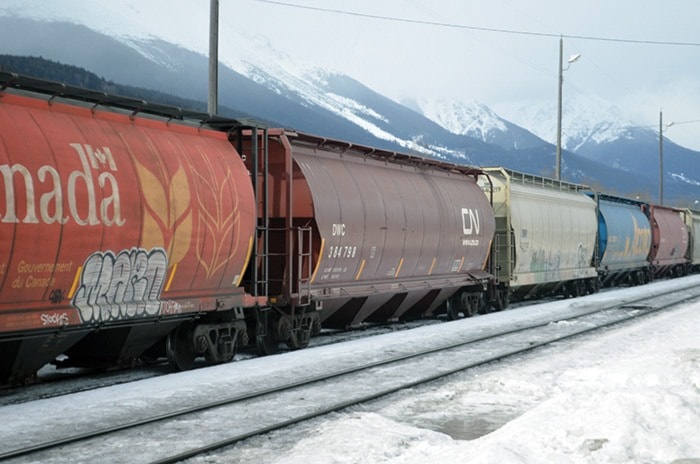Representatives from CN Rail attended a Committee of the Whole meeting last Tuesday evening to discuss safety procedures and protocol in the event of a rail disaster in the Bulkey Valley.
“The recent events in Lac-Megantic over the summer have heightened awareness about safety procedures and we are trying to be as transparent as possible,” CN Rail Senior Dangerous Goods Office Lee Nelson said.
During the hour long presentation, Nelson outlined safety protocol, CN Rail’s safety track record and went over details about the types of goods carried through Smithers. Councillors, citizens and fire chiefs from around the Bulkley Valley responded with questions and concerns.
Regional District Bulkley-Nechako representative Stoney Stoltenberg got the debate rolling after the presentation was finished. “We have a lot of volunteer firefighters who do the job out of a commitment to their community,” Stoltenberg said. “I would say to every chief here that the first thing you do is evacuate and sit there and wait for CN to come.”
“Essentially,” Nelson responded. “I would say that is the mandate and based on the chemicals involved, that is the proper procedure. “We don’t have emergency response accountability. From a CN perspective, that is not our role at this time.”
With CN Rail’s emergency response team based out of Edmonton and Richmond the compnay estimates a 12-14 hour wait until they reach Smithers, though one former railroad engineer in the audience called that time frame “extremely optimistic.”
As a result of the wait time, local emergency responders would be forced into a holding pattern, waiting to find out information about dangerous goods and about the correct procedure to follow.
“Should we be satisfied with that time-frame?” Mayor Bachrach asked Nelson.
“The wait time is not ideal,” Nelson said. “But we are operating in accordance with government protocol.” Their compliance with regulations means that any changes to emergency response times will likely have to be mandated by new legislature.
“We aren’t questioning whether or not CN is meeting the bar,” Bachrach said. “We are questioning whether the bar is set in the right place, in order to protect our communities.” “I think council is very motivated to follow up on this meeting to ensure that response times are adequate.”
On the positive side, only one per cent of all cars carry dangerous goods through Smithers. Though that number is low compared to the national average, it could be on the rise with increased industrial energy production in Alberta and Northeastern B.C.
Also of concern, the Montreal, Main and Atlantic Railway line’s lack of insurance coverage that forced them into bankruptcy after the Lac-Megantic disaster and left the federal government and Quebec’s provincial government on the hook for upwards of $200 million in rebuilding costs.
It’s an outcome CN assures won’t happen on their rail lines.
“That event was isolated and was the result of the situation bankrupting a smaller company,” Ben Tessier, of the CN police, said.
He went on to claim that the company would cover any and all costs from a disaster.
However, CN’s current insurance levels are mandated by Transportation Canada, and those levels are not released to the public.
Bulkley-Nechako MP Nathan Cullen called for more transparency and greater accountability.
“It amounts to a public subsidy,” Cullen said. “The public pays for damages because, far too often companies declare bankruptcy and are able to slip through the noose, leaving the public on the hook.
“It’s not all that different with an oil tanker spill. They say the right things and then, a year later when the media is gone, they renege on their financial commitments.”
Nelson touted CN’s safety record and declining accident numbers over the past six years, though their accident reporting protocol has been called into question, most recently by the CBC, which purported that CN was under-reporting its accidents due to a bonus system that rewards executives for lower incident totals.
“It’s a case of the fox guarding the henhouse,” Cullen said. “You put big financial incentives in front of executives and encourage them not to report. They run roughshod over safety rules.”
Turning to more practical matters, town and local fire chiefs are also considering a table top evacuation drill that will help prepare them in the event of an emergency.
“We would be more than willing to come to your community and go through some exercises with you,” Nelson said at the meeting.
Smithers Fire Chief and emergency program coordinator Keith Stecko is open to the possibility of a table top drill, in conjunction with CN Rail sometime in the near future.
“I think we have to take advantage of any opportunity where we can exercise an event and work through potential issues that could arise and identify challenges we could be facing,” Stecko said.
“That would be beneficial to everyone.”
Stecko stressed the importance of reassessing and improving their current protocol.
“From here, we need to drill down on some of the things we heard and standardize an emergency planning process for railways and municipalities and coordinate those roles.
“I think this was a positive first step,” Stecko said. “And I think we need to move forward with this.”
Mayor Bachrach finished the meeting by stating the current and historical importance of the railroad to the community of Smithers.
“We are a railroad town,” Bachrach said. “The town was founded by the railroad just over 100 years ago and our relationship with CN is very important to us.”
